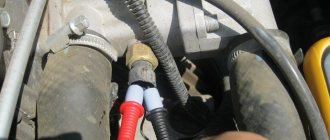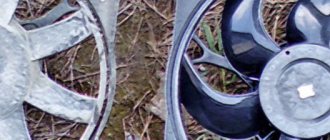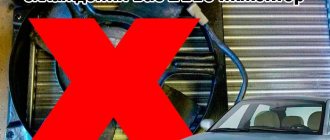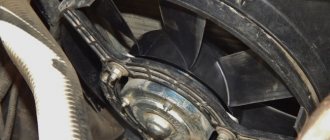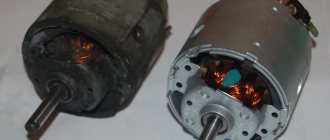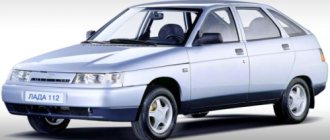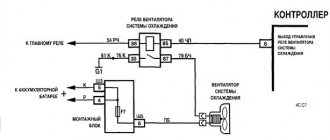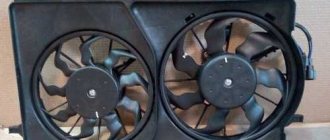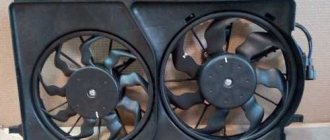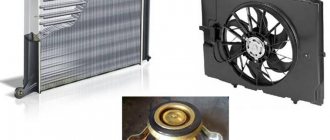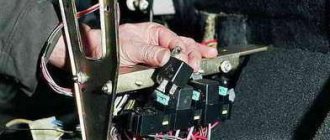All cars with an injection engine have an electric fan, not a mechanical one. Mechanically everything was simpler... The fan motor is connected to the network through a relay, and the signal to this relay is supplied by the ECU. Additionally, there is a fuse in the motor circuit, and the antifreeze temperature sensor (ATS) is connected directly to the ECU. If the cooling fan does not work, you can do one trick on the VAZ-2114: turn off the DTOZh sensor and start the engine. And if the fan starts spinning, the problem must be looked for in the sensor.
To avoid having to examine the wiring inside and out, just watch one video. Everything here has already been done.
Cooling fan diagnostics - trying to find the problem
There will be two temperature sensors: one, which is on the thermostat, is connected to the ECU. It is necessary to turn it off - leave the second one as it is.
DTOZH on engine 11183
We disconnect the connector, but do not remove the sensor itself. Then we turn the key to position 1, and so on.
Electrically, things look complicated: the fan relay is in one box, and the fuse is in another. We need fuse F5 (20A). By the way, both a fan and a horn are connected to it.
Mounting block 2114-3722010-60 and 2114-3722010-10
The main mounting block is installed under the hood, and the additional one is located at the left foot of the front passenger.
Additional mounting block (option 1)
In the additional block we see three relays. The "main relay" is located at the bottom. And then there are possible options:
- The fan relay is mounted in the middle;
- This relay can also be installed at the top.
The second option is shown below.
Additional mounting block (option 2)
By the way, there is always a fuse located near the relay we need. It is part of the fan circuit.
Fuses 2114-2113-2115
| Decoding | |
| F9 (7.5 A) | Right fog lamp |
| F8 (7.5 A) | Left fog lamp |
| F1 (10 A) | Headlight cleaners (at the moment of switching on). Relay for turning on the headlight cleaners (contacts). Headlight washer activation valve |
| F7 (30 A) | Headlight cleaners (in operating mode). Relay for turning on headlight cleaners (winding). Electric heater fan motor - heater fuse. Electric motor for windshield washer. Rear window wiper gearmotor. Rear window washer timing relay. Windshield and rear window washer activation valves. Relay (winding) for turning on. electric fan of the engine cooling system. Relay (winding) for turning on the heated rear window. Warning lamp for heated rear window. Glove compartment lighting lamp |
| F16 (15 A) | Direction indicators and relay-interrupter for direction indicators and hazard warning lights (in turn indication mode). Turn signal indicator lamp. Rear lights (reversing lamps). Gearbox and windshield wiper activation relay. Generator excitation winding (when starting the engine). Brake fluid level warning lamp. Oil pressure warning lamp. Carburetor air damper warning lamp. Parking brake warning lamp. STOP light display lamp. Coolant temperature indicator. Fuel level indicator with reserve warning lamp. Voltmeter |
| F3 (10 A) | Rear lights (brake lamps). Interior lighting |
| F6 (30 A) | Power windows for front doors. Power window relay |
| F10 (7.5 A) | License plate lights. Engine compartment lamp. Instrument lighting lamps. Exterior lighting control lamp. Heater lever illumination display. Cigarette lighter lamp |
| F5 (20 A) | Electric motor of the engine cooling system fan, and its activation relay (contacts). Sound signal and its activation relay |
| F10 (7.5 A) | Left headlight (side light).Left rear light (side light) |
| F11 (7.5 A) | Right headlight (side light). Right rear light (side light) |
| F2 (10 A) | Direction indicators and hazard warning relay (in hazard mode). Hazard warning lamp |
| F4 (20 A) | Rear window heating element. Relay (contacts) for turning on the rear window heating. Plug socket for portable lamp. Cigarette lighter |
| F15 (7.5 A) | Right headlight (high beam) |
| F14 (7.5) | Left headlight (high beam). Indicator lamp for turning on high beam headlights |
| F13 (7.5 A) | Left headlight (low beam) |
| F12 (7.5 A) | Right headlight (low beam) |
You may have a VAZ 2114 fuse box of a different type. The diagram is presented below.
- K1 - Relay for turning on headlight cleaners
- K2 - Relay interrupter for direction indicators and hazard warning lights
- K3 - Windshield wiper relay
- K4 - Relay for monitoring the health of brake lamps and side lights
- K5 - Power window relay
- K6 - Horn relay
- K7 - Heated rear window relay
- K8 - Headlight high beam relay
- K9 - Relay for low beam headlights
- F1 - F16 - Fuses
- F1 - F20 - Spare fuses
| Fuse no. | What does it affect? |
| F1 (10 A) | Fuse for fog lights VAZ 2114, 2115 - rear fog light lamps and rear fog light indicator lamp |
| F2 (10 A) | Direction indicators, relay-interrupter of direction indicators and hazard warning lights (in hazard warning mode) Hazard warning lamp |
| F3 (7.5 A) | Front interior lamp. Central interior lamp. Luggage compartment lighting. Illumination lamp for the ignition switch. Lamp for monitoring the engine management system. Brake light bulbs. Trip computer (if installed) |
| F4 (20 A) | Socket for connecting a portable lamp. Relay for turning on the heated rear window (contacts). Rear window heating element |
| F5 (20 A) | Sound signal. Horn relay. Cooling fan electric motor. Fan fuse. |
| F6 (30 A) | Electric windows. Power window relay (contacts) |
| F7 (30 A) | Heater electric motor. Heater fuse for VAZ 2114, VAZ 2115. Electric motor for windshield washer. Headlight wiper motors (in operating mode) Cigarette lighter fuse. Glove box lighting lamp. Rear window heating relay (winding) |
| F8 (7.5 A) | Fuse for fog lamps VAZ 2114, 2115 - Right fog lamp |
| F9 (7.5 A) | Fuse for fog lamps VAZ 2114, 2115 - Left fog lamp |
| F10 (7.5 A) | Side light lamps on the left side. Indicator lamp for turning on the side light. License plate lamps. Engine compartment lamp Instrument lighting switch. Fuse for backlight lamps of switches, instruments, cigarette lighter, ashtray, heater control levers |
| F11 (7.5 A) | Side light lamps on starboard side |
| F12 (7.5 A) | Right headlight (low beam) |
| F13 (7.5 A) | Left headlight (low beam) |
| F14 (7.5 A) | Left headlight (high beam). High beam indicator lamp |
| F15 (7.5 A) | Right headlight (high beam) |
| F16 (15 A) | Direction indicators, relay-interrupter for direction indicators and hazard warning lights (in turn indication mode). Reversing lamps. Relay for monitoring the health of lamps. On-board control system display unit. Instrument cluster. Insufficient oil pressure indicator lamp. Parking brake indicator lamp (brake light fuse). Brake fluid level indicator lamp. Low battery indicator lamp. Trip computer (if installed). Generator field winding (in engine starting mode) |
If such a unit fails for some reason, you can buy it here.
The fan does not work - we change it ourselves
Try to do this: you need to remove the negative terminal from the battery (the key is “10”), and then disconnect the motor connector.
Fan power connector
If you now connect the battery again, you can call “+12” on one of the two terminals. Now you can go all-in: the negative cord from the fan is connected to ground using a T-connector. Often on the VAZ-2114 hatchback the fan does not work because it is not the wiring that is faulty, but the motor. And then they perform the replacement.
Dismantling, all steps
Once again, make sure that you have disconnected the battery. Disconnect the connector as discussed above. Next, use a socket wrench to unscrew the two nuts holding the “stopper” (see photo).
Retaining bracket above the casing
There are four nuts at the corners of the plastic frame. They need to be unscrewed with a 10mm key.
One of four nuts
The mounting frame together with the fan is removed in the “up” direction. As you can see, everything is simple.
Installation of the unit is carried out in the reverse order. It will be possible to replace both the motor and the casing frame.
Articles
- 2108-1309010 – casing;
- 2109-1308008 (-01, -02) – motor assembled with impeller;
- 2103-1308010-10 – impeller;
- 12605571 – lock washer;
- 16102311 – M8 nut.
Purpose
The cooling fan is designed to cool the radiator with air, which it pumps with its impeller. Most often, the fan turns on in hot weather or when the car is stuck in a traffic jam, at these moments the fan is an indispensable part that keeps the engine from overheating.
What can happen to the engine if the cooling fan does not work:
- Due to severe overheating, the coolant may boil away and its level will drop significantly, which will reduce the engine cooling coefficient;
- Due to a significant increase in temperature, crankshaft liners and camshaft pastels, as well as valve seals, may be damaged;
- Possible occurrence of piston rings, both compression and oil scraper;
- Possible breakdown of the cylinder head gasket;
- Engine wedge;
As you can see, if the cooling fan does not work, this can lead to serious consequences, after which it will be necessary, if not a major, then a serious repair of the VAZ 2114 engine.
Conclusions: what exactly should be done if the fan does not work (action algorithm)
First, check whether the “plus” is connected to one of the terminals in the connector. Then connect the connector from ground to check the serviceability of the electric motor. In some cases, you can observe this:
- Both fuse F5 and the additional fuse are working;
- The fan relay operates as expected;
- The DTOZh sensor is working;
- The motor can only be turned on by applying a potential of “0 Volt”.
There will be only one conclusion: the ground contact has come loose, which ends the entire power line. This means you will need to contact an auto electrician. All other faults can be overcome by yourself.
Element F5 may burn out as a result of the horn closing. But then “+12” is not called up on the connector, which should immediately alert you.
Operating principle, design and characteristics of fuses
The principle of operation of fuse links is deciphered by their name. Fuses are made of low-fusible conductors that can withstand a certain amperage. Depending on the purpose and voltage of the circuit being served, fuses are divided according to the current strength they can withstand. Typically, VAZ 2114 uses inserts from 5 to 30 Amperes.
Purpose of fuses
The main purpose of the fuse is to protect devices and equipment from overloads and short circuits. If the maximum limit is exceeded (short circuit inside the wiring circuit), the part is destroyed, which leads to an open line. Consequently, the part remains undamaged.
Common faults
Among the frequent calls to the service station are:
- wiring burnout;
- water entering the contacts and, as a result, closing them;
- damage to wires;
- malfunctions of electronic units.
With rare exceptions, the fuse box itself breaks down.
Checking and replacing fuses and block
To check the fuse for serviceability, remove it from the socket and visually inspect it. If the part is intact, there will be no soot or traces of oxidation on it. Direct replacement is carried out using the pliers included in the kit. It is strictly forbidden to pull out the inserts by loosening them - you can break the legs.
Repairing the block is getting more complicated. Here you will need to perform the following sequence of actions:
- open the mounting panel cover;
- find and unscrew the 4 mounting screws;
- Carefully lift the module and disconnect the terminal blocks.
It is important to exercise extreme caution when performing the procedure - the part can be easily damaged.
Vintage tape recorders and audio equipment | Topic author: Group
Good afternoon. My Sobol Barguzin engine 405 22 for some reason gets very hot both in winter and summer. The mileage is only 13,000 km. Tell me the reason for this unpleasant phenomenon. Thanks in advance!
Sergey (Joetta) What do you mean it gets very hot? I have the same one and it gets hot too. In winter there are only traffic jams, but in summer there are always traffic jams.
Anatoly (Birgitta) At 90 degrees the fan turns on, it doesn’t disturb much. Well, in traffic jams it’s like the law comes to the top.
Sergey (Joetta) Change the radiator to a 3-row one.
Sergey (Joetta) It happens to me all the time. The car is 10 years old and I’m driving the second engine - the same thing. I installed all sorts of radiators, but now I just don’t bother. The fan turns on at 93 and turns off at 90. I also drove through the mountains in Sochi and nothing. The main thing is that the cooling is working properly.
Sergey (Joetta) What do you have for cooling? Electric coupling or Carlson? If it is an electric coupling, then for better cooling it is necessary to add gas in the traffic jam at idle. If it’s Carlson, then it’s better to use Bosch ones with larger blades, rather than Volgov ones. It cools better.
Anatoly (Birgitta) Thank you for responding to my problem! Best wishes.
Sergey (Joetta) I removed the original fan from the electric coupling and installed an electric fan on a Bosch radiator and a Zhiguli switching sensor through a relay. The sensor was set with a response temperature of 82-85 degrees Celsius. And in the heat and in traffic jams the temperature does not rise above 85. And at the same time I live in Astrakhan where the heat is constant. THE MOUNTING ON THE RADIATOR UNDER THE FAN AND THE FAN ITSELF COST ME ONLY 1900 RUBLES.
Sergey (Joetta) I removed the original fan from the electric coupling and installed an electric fan on a Bosch radiator and a Zhiguli switching sensor through a relay. The sensor was set with a response temperature of 82-85 degrees Celsius. And in the heat and in traffic jams the temperature does not rise above 85. And at the same time I live in Astrakhan where the heat is constant. THE MOUNTING ON THE RADIATOR UNDER THE FAN AND THE FAN ITSELF COST ME ONLY 1900 RUBLES.
Anatoly (Birgitta) I read the advice. Thank you very much!
Sergey (Joetta) Isn’t the temperature too low for this engine? And where did you put the sensor? I did the same thing, but I turned on the fan by turning on the electric coupling (via a relay, of course). But problems constantly arose: either the wire on the fan broke, or there was a contact, or the relay did not work or went sour, or something else often boiled, but as long as I drove with the electric coupling, there were no overheating or problems. Yes it is noisy. By the way, the clutch activation temperature can be adjusted in the firmware, as far as I know. Just put it lower and that’s it.
Sergey (Joetta) Before installing the electric fan, I replaced the radiator, which already had a fitting for the Zhiguli sensor. Copper double-row radiator. It cost me 2900 rubles. As for the temperature for this engine, its normal operating temperature according to the data sheet is 80-90 degrees. And here's another thing. If the radiator does not have a fitting for the sensor, then a pipe with a fitting is sold. Cut the top hose and insert this pipe. My engine started to boil when I stopped the car and turned it off immediately. And that’s why I had to stop and wait for some time until it cooled down a little. And now I turn off the car immediately and if the engine is hot, the fan runs until the temperature drops because it runs directly from the battery through the fuse.
Sergey (Joetta) It’s better to have a pipe with a fitting. This topic has been raised on gazelle forums for a long time. If the sensor is in the radiator, then the temperature there is lower than the real one and everyone blocked the pipe with the sensor. I set this up as a parallel to my native inclusion. I also recommend a separate button in the interior to force the fan to turn on. You place it parallel to the sensor. Helped me in some cases.
Pavel (Morgana) on BC in the summer I set the temperature for turning on the fan to 83-85 degrees. and just to be sure, a forced button... the problem is gone.
Dima (Acacia) the normal operating temperature of this engine is 95-105 degrees; I have a 98 sensor for the winter, 92 for the summer, but it works at 93-97
Video - connecting and checking VO
The domestic car VAZ 2114 (Samara-2) is built on the VAZ 21093 platform and is an improved version of it. The interior features a new instrument panel, a new steering wheel, an adjustable steering column, power windows and a new heater. All diagrams are taken from open sources and are intended to help in self-repair of the electrical equipment of this car. Enlarge images by clicking. The VAZ 2114 fuse box is located in the passenger compartment under the dashboard. When checking the electrical circuit of a VAZ-2114 car, you cannot check the serviceability of the circuits for a “spark” - this can lead to burnout of the current-carrying paths of the mounting block.
